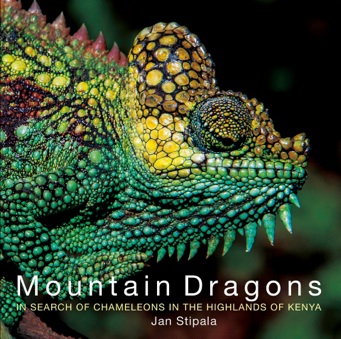



Review: Mountain Dragons
By Christopher V. Anderson, PhD
Citation:
Anderson, C.V. (2014). Review: Mountain Dragons. Chameleons! Online E-Zine, June 2014. (http://www.chameleonnews.com/14JunAndersonMountainDragons.html)

Mountain Dragons: In Search of Chameleons in the Highlands of Kenya
By: Jan Stipala
Hardbound: 123 pages; 0.75” x 12” x 12”
Published By: Jan Stipala, Copyright 2014
ISBN # 978-0-9928176-0-2
List Price: £26
Available Exclusively at:
http://www.mountaindragons.com
“Mountain Dragons” is the culmination of a year spent exploring the highlands of Kenya by Jan Stipala as he studied the chameleon diversity of the region, collecting data for what ultimately became his Ph.D. dissertation. In this book, where he aims to paint a picture of Kenyan chameleon diversity for the general public and chameleon enthusiast, Stipala provides exceptional accounts of a wide range of chameleon species from a variety of incredibly unique habitats, all accompanied by exceptional photographs and detailed ecological information.
Stipala’s book begins by explaining the geology and climate of the Kenyan highlands, which have formed “an archipelago of ecological islands for montane-adapted chameleons”. He provides a highly informative, yet broadly accessible, overview of the evolutionary history of the chameleons of the region, followed by an engaging description of the background leading up to his expedition, and stories of the trials and tribulations associated with it.
This is followed by a travelogue with photos and observations from different localities of the central and western highlands. Here, Stipala provides a previously unmatched selection of exceptional photographs of a variety of chameleon habitats, chameleon species and subspecies, and locale-specific color variations from this region. The diversity shown for Trioceros jacksonii and T. hoehnelii localities in particular, is truly remarkable. The extent of this variation had never really been shown before, and Stipala includes photographs in his book of localities and color variations that most have never seen, and some from slopes and mountains with no prior chameleon records.
At the same time, incredible photographs of several rare species, including Kinyongia excubitor, Trioceros kinangopensis, T. nyirit, T. conirostratus, and Kenyan T. sternfeldi localities, are included. Some of these species were described to science by Stipala as a result of his work in Kenya, and this work provides the most extensive set of photos of these species yet. Additionally, Stipala outlines numerous range extensions for a variety of species, some of which may represent distinct species or subspecies to be described in the future.
Following the impressive travelogue, Stipala provides profiles for each species he encountered during his expedition. While this is not an exclusive list of the chameleon species of Kenya (he did not survey more Northern and eastern localities in Kenya), its coverage is quite extensive, with a considerable amount of very useful information, including altitudinal range maps, morphological and color descriptions, and ecological notes.
Stipala ends this book with a section that includes description of some of the scientific results he has found from the data collected during his expedition. Much of this data in currently unpublished, but provides interesting insight into evolutionary trends of these species, including hints of potential taxonomic changes to some of these species and localities in the future.
Scattered throughout the book, Stipala also includes large content boxes on a variety of topics, including information about finding chameleons in the wild, photographing chameleons, and information about chameleon breeding farms in Kenya. These sections are of particular interest to those interested in trying to find chameleons in the wild for the first time and then photographically document their finds. Further, chameleon keepers may also find photographs and descriptions of the process by which T. jacksonii and T. hoehnelii are farmed in Kenya of great interest.
Overall, Stipala has provided an incredible reference and beautiful coffee table book for chameleon enthusiasts, researchers, those interested in the fauna of Kenya, and undoubtedly a large group of people who will simply find the beauty of these animals as depicted in this book irresistible.
If you are interested in purchasing this book, it is only available through:
http://www.mountaindragons.com/

Christopher V. Anderson, PhD

Chris Anderson has a Ph.D. in Biology (Physiology & Morphology) from the University of South Florida’s Department of Integrative Biology, where he studied the effects of temperature on ballistic tongue projection and tongue retraction in chameleons for his dissertation. Currently a Postdoctoral Researcher at Brown University, Chris is also a member of the IUCN/SSC Chameleon Specialist Group. His chameleon research has been published in top scientific journals and books, and the results have been featured in popular press and news outlets all over the world. He has traveled extensively to chameleon habitats around the world, including conducting work with chameleons in Madagascar, South Africa and Cameroon, as well as introduced populations in Florida. Further, Chris has been keeping chameleons since 1997, and since then has worked with over 70 different species and subspecies in captivity. Currently, Chris is the Editor and Webmaster of the Chameleons! Online E-Zine. Chris’ personal website can be found at www.chamaeleonidae.com and he can be emailed at either Chris.Anderson@chameleonnews.com or Furcifer.minor@gmail.com.









Join Our Facebook Page for Updates on New Issues:
© 2002-2014 Chameleonnews.com All rights reserved.
Reproduction in whole or part expressly forbidden without permission from the publisher. For permission, please contact the editor at editor@chameleonnews.com
